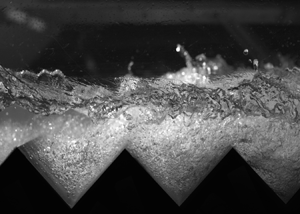Article contents
Linking turbulent waves and bubble diffusion in self-aerated open-channel flows: two-state air concentration
Published online by Cambridge University Press: 05 July 2023
Abstract

High-Froude-number flows become self-aerated when the destabilizing effect of turbulence overcomes gravity and surface tension forces. Traditionally, the resulting air concentration profile has been explained using single-layer approaches that invoke solutions of the advection–diffusion equation for air in water, i.e. bubbles’ dispersion. Based on a wide range of experimental evidence, we argue that the complete air concentration profile shall be explained through the weak interaction of different canonical turbulent flows, namely a turbulent boundary layer (TBL) and a turbulent wavy layer (TWL). Motivated by a decomposition of the streamwise velocity into a pure wall flow and a free-stream flow (Krug et al., J. Fluid Mech., vol. 811, 2017, pp. 421–435), we present a physically consistent two-state formulation of the structure of a self-aerated flow. The air concentration is mathematically built upon a modified Rouse profile and a Gaussian error function, resembling vertical mass transport in the TBL and the TWL. We apply our air concentration theory to over 500 profiles from different data sets, featuring excellent agreement. Finally, we show that the turbulent Schmidt number, characterizing the momentum-mass transfer, ranges between 0.2 and 1, which is consistent with previous mass-transfer experiments in TBLs. Altogether, the proposed flow conceptualization sets the scene for more physically based numerical modelling of turbulent mass diffusion in self-aerated flows.
JFM classification
- Type
- JFM Papers
- Information
- Copyright
- © The Author(s), 2023. Published by Cambridge University Press
References
- 6
- Cited by



